HIGH CHARGE-STATE ION BEAM PRODUCTION FROM
A LASER ION SOURCE
M. Bourgeois, G. Hall, H. Haseroth, S. Kondrashev*,
H. Kugler, K. Langbein, A. Lombardi, K. Makarov**, W. Pirkl, Y. Satov**,
R.M. Scrivens, B. Sharkov*, A. Shumshurov*, A. Ster, A.J. Tambini, E. Tanke
PS Division, CERN, CH-1211 Geneva 23, Switzerland
* ITEP, B. Cheremushkinskaya 25, Moscow, Russia
** TRINITI, Troitsk, Moscow Region, Russia
Abstract
The high current, high charge-state ion beam which can be extracted from a laser produced plasma is well suited, after initial acceleration, for injection into synchrotrons. At CERN, the production of a heavy ion beam using such a source is studied.
A 60 mA pulse of a mixture of high charge state tantalum or lead ions of 5 ms duration has been extracted at 59 kV. The resulting beam emittance and energy spread were measured.
A Low Energy Beam Transport system (LEBT) consisting of two pulsed solenoids is used to match the beam to a four-rod Radio Frequency Quadrupole (RFQ).
Preliminary results are given for the acceleration of
the beam by an RFQ, designed for the acceleration of 10 mA of Ta16+
to an energy of 100 keV/u.
Introduction
The demand for high intensity, high charge-state heavy ion beams for HEP experiments has prompted the study of a Laser Ion Source (LIS) at CERN since 1989 [1-3]. In recent publications the creation and extraction of a high charge-state heavy ion beam [2] and the acceleration of an aluminium 9+ and 10+ beam using a four-vane RFQ [3] have been reported.
In 1996 a new LEBT and a new four-rod RFQ designed for
the acceleration of heavy ions have been installed. The first results of
this device are presented here.
Apparatus
A schematic of the layout of the LIS and pre-accelerator
is shown in Fig. 1.
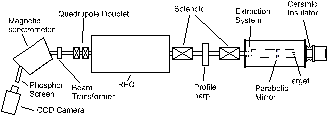
Fig. 1. Schematic
of the layout of the CERN laser ion source and pre-accelerator.
Source
A free running CO2 laser (l=10.6 mm), produces an output pulse of 30 J. Approximately half the energy is present in the first peak of 50 ns (FWHM).
The beam is focused onto the tantalum target with a spot size of 35 mm (calculated [4]), where the first temporal peak is responsible for the generation of the ions of high charge-states in the hot dense plasma.
The plasma expands through a hole in the mirror and an expansion region to the extraction region. The target chamber and expansion region are isolated from ground and can be held at voltages up to 80 kV.
The extraction system consists of an accel/decel system
with 3 plane electrodes with apertures of 30 mm and an extraction
gap of 30 mm.
Low Energy Beam Transport and Matching line
The beam is matched to the RFQ using a simple LEBT consisting of two pulsed magnetic solenoids, with effective lengths of 350 mm. A large inner-diameter (120 mm) is used to reduce spherical aberrations. The maximum magnetic field on axis is 1.4 T. The inner diameter of the vacuum chamber is 100 mm.
A profile harp and a Faraday cup between the solenoids
are used for beam analysis. Two dipole magnets are included for trajectory
correction.
RFQ
The four-rod RFQ [5] is designed to accelerate ions with
charge to mass ratios higher than 0.0865 (applicable for tantalum charge-states
þ16+), with up to 60 mA of a mixture of charge states. It operates
at a frequency of 101 MHz and accelerates ions from 6.9 to 100
keV/u. The input acceptance is 300 mm.mrad.
Medium Energy Beam Measuring Line
After the RFQ there is a line of measuring equipment including
a Faraday cup and beam current transformers. Two quadrupoles allow the
full beam current to be transported through a magnetic spectrometer. A
phosphor screen is positioned after the spectrometer for measurements of
the energy dispersion and charge-state distribution (CSD).
Results
Tantalum Plasma Charge State Distribution
An electrostatic spectrometer has been used to measure
the abundance of different charge-states in the un-accelerated plasma which
pass through the extraction electrode apertures. Due to the large energy
spread of ions in the plasma, ions with the correct energy per charge ratio
for the spectrometer exist for many charge-states. As the production time
for all ions is less than 1 ms, a time-of-flight (TOF) spectrum can
be recorded using a Secondary Electron Multiplier (SEM) tube positioned
after the spectrometer (see Fig. 2).
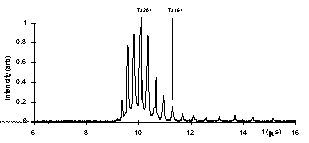
Fig. 2. TOF spectrum
of the unaccelerated plasma, measured with an electrostatic analyser 2.5 m
from the target.
TOF spectra are recorded over a range of different spectrometer
voltages and the data are processed to produce a CSD. Fig. 3 shows the
CSD of tantalum ions which pass through the 30 mm extraction apertures
during the time interval 3-8 ms after the laser pulse (target to extraction
distance: 0.9 m). At present no precise secondary electron emission
coefficients (g ) exist for CuBe (the SEM material) for bombardment
by high charge-state Ta ions at energies in the range 0.5-10 keV/q. Therefore
the processed data (a) after scaling to the total current of 60 mA
have been corrected assuming that g is only a function of the ion
kinetic energy (b) [6], and a function of the potential energy (c) [7].
The first qualitative measurements of g suggest the energy range
0.5-10 keV/q lies between the regions (b) and (c).
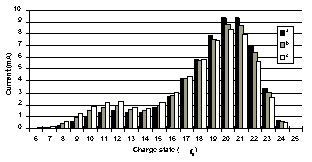
Fig. 3. Charge-state
distribution of the unaccelerated plasma. Measured data processed under
the assumption that a) the secondary electron emission coefficient (g
) of CuBe is independent of charge-state and kinetic energy, b) g
scales with ion kinetic energy, c) g proportional to charge-state.
The group of lower charge-states (centered around Ta12+)
can be explained by the reflected laser pulse (reflected from the plasma,
to the laser cavity and back to the plasma). This is confirmed by simulations
[8].
Extracted Ion Beam
Measurements of the total current, current per charge-state and emittance of the extracted ion beam have been made.
The current measured with a Faraday cup placed 24 mm
after the ground extraction electrode is shown in Fig. 4.
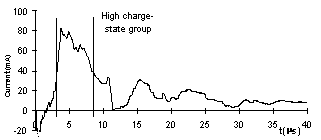
Fig. 4. Beam current
measured with a 30 mm aperture Faraday cup positioned 24 mm after
extraction. High charge-state Ta beam is indicated from 3-8ms after the
laser pulse.
During the time window from 3-8 ms after the laser pulse, during which the high charge-state ions are expected, the average current is 64 mA. After this time the beam consists mainly of lower charge-state ions.
The beam emittance was measured using a pepper-pot, phosphor screen and CCD camera arrangement. The CCD camera is gated from 3 - 8 ms to measure only the high charge-state group. A typical reconstructed phase space plot is shown in Fig. 5, where the total combined emittance for all extracted ions in the horizontal plane is 250 mm.mrad. The beam was extracted at 59 kV in order to match the RFQ input energy of 6.9 keV/u for Ta20+.
Measurements of the CSD of the high charge-state group
after extraction, show a distribution similar to that measured in the plasma.
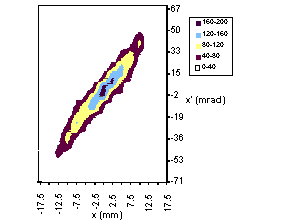
Fig. 5. Horizontal
phase space plot of a Ta beam measured 79 mm after extraction. The
4 x rms emittance was 250 mm.mrad.
Beam Matching to the RFQ
Before the installation of the RFQ, measurements were made of the beam transported through the LEBT line. The extraction voltage was set to 59 kV to match the most abundant charge-state, Ta20+, to the RFQ input energy.
The total beam current was measured behind an aperture of 6.5 mm using similar focusing conditions to those used for RFQ injection (Fig. 6).
The size of the focal spot was measured at the end of the LEBT with a phosphor screen and CCD camera (Fig. 7). The different focal length for different charge-state leads to a "long" beam waist of the order of 50 mm.
The charge-state distribution in the focal spot was estimated
from measurements with the magnetic spectrometer, phosphor screen and CCD
camera. Percentages for each state are Ta17+:11%, Ta18+:17%,
Ta19+:20%, Ta20+:20%, Ta21+:19%, Ta22+:13%.
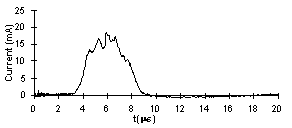
Fig. 6. Beam current
(average of 3 shots) measured at the RFQ input plane with a 6.5 mm
aperture Faraday cup.
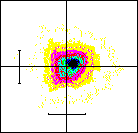
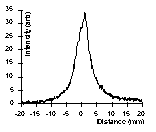
Fig. 7. a) Image of the beam focal spot on a phosphor screen positioned at the RFQ input plane (recorded using a gated CCD camera) b) Horizontally integrated intensity plot.
Accelerated Beam Current
An output beam current of 2 mA (5 ms average) was measured with a Faraday cup at the RFQ exit (see Fig. 8), containing five charge-states with intensity ratios of Ta18+: 4%, Ta19+: 15%, Ta20+: 39%, Ta21+: 30% and Ta22+: 12%.
The average energy is 97 keV/u for all charge-states and the total energy spread is 5 keV/u for Ta20+.
The transverse emittance has been measured as 22 mm.mrad
(4 x rms un-normalised) using the pepper-pot and phosphor screen arrangement.
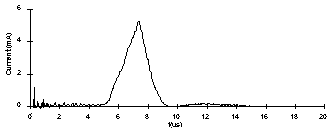
Fig. 8. RFQ output
beam current (average of 3 shots) measured with a Faraday cup behind the
MEBT quadrupoles.
Conclusion
The first results of the CERN laser ion source show 1-2 mA
(peak current) in each of 3 charge-states around Ta20+, accelerated
to 97 keV/u, within a transverse emittance of 22 mm.mrad (4 x
rms). The experimental system consists of a free-running CO2
laser providing 15 J in the first peak, 59 kV at ion extraction
from the plasma, a simple 2 solenoid beam transport and an RFQ designed
for high charge-state heavy ions. The optimization of the full ensemble
has just begun.
Acknowledgments
The work detailed in this report would not have been possible
without the aid of CERN's survey team, RF group, vacuum group, magnet group
and mechanical support.
References